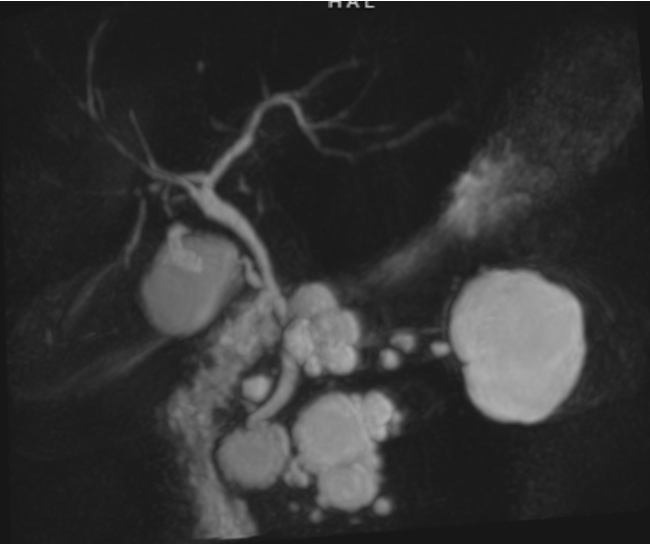Monday Poster Session
Category: Biliary/Pancreas
P2253 - Diagnosis of Von Hippel-Lindau Syndrome via Pancreatic Cyst Fluid Next-Generation Sequencing
Monday, October 27, 2025
10:30 AM - 4:00 PM PDT
Location: Exhibit Hall
- SH
Syedreza Haider, MD
University of Michigan
Ann Arbor, MI
Presenting Author(s)
Syedreza Haider, MD1, Jonathan Y. Xia, MD, PhD2
1University of Michigan, Ann Arbor, MI; 2University of Michigan, Ann arbor, MI
Introduction: Von Hippel-Lindau (VHL) syndrome is an autosomal dominant disorder associated with a variety of benign and malignant tumors. While germline testing is the diagnostic standard, we report a case in which somatic next-generation sequencing (NGS) of pancreatic cyst fluid uncovered VHL syndrome highlighting the expanding diagnostic utility of molecular cyst fluid analysis.
Case Description/
Methods: A 44-year-old woman with no prior medical or family history experienced sudden-onset headache while traveling in Germany and was found with subarachnoid hemorrhage. She was stabilized and transferred back to the United States where imaging showed a cervical hemangioblastoma requiring embolization and resection. During her hospitalization, CT revealed multiple pancreatic cysts and a left renal mass. Despite the multisystem findings, no unifying diagnosis was made.
She was referred to GI for further evaluation where MRI/MRCP confirmed multiple pancreatic cysts, the largest measuring 4.8 cm in the pancreatic body (Fig.1). On endoscopic ultrasound, this cyst was unilocular and anechoic without solid components or septations (Fig.2). FNA yielded 15 cc of thin clear fluid. Cytology showed no high-grade dysplasia or malignancy. Fluid studies revealed amylase 46 IU/L, CEA < 1 ng/mL, and glucose 99 mg/dL, which is consistent with a serous cystadenoma. However, pancreas cyst fluid NGS (PancreaSeq) identified a pathogenic protein-truncating VHL mutation (c.481delC, p.R161fs; AF 23%) with no KRAS, GNAS, BRAF, or RNF43 alterations. Germline testing confirmed VHL syndrome. The patient is undergoing neurorehabilitation and is scheduled for genetic counseling and surveillance of VHL-associated neoplasms.
Discussion: This case highlights the value of NGS of pancreatic cyst fluid in identifying syndromic conditions, even when conventional fluid studies are non-diagnostic. The cysts lacked high-risk features on imaging, and fluid analysis was consistent with a benign serous cystadenoma. Without NGS, the diagnosis of VHL may have been delayed or missed. Additionally, relying solely on germline testing, particularly in conditions like VHL, where mosaicism may lead to false negatives could have missed the underlying genetic etiology. Pancreatic cyst fluid NGS should be considered when imaging and clinical context raise suspicion, as early diagnosis can prompt targeted surveillance and management for multi-organ disease.

Figure: Fig. 1 . MRI image showing multiple pancreas cysts with the largest measuring 48 mm in the distal body of the pancreas.

Figure: Endosonographic appearance of the large cyst in the distal pancreas body.
Disclosures:
Syedreza Haider indicated no relevant financial relationships.
Jonathan Xia indicated no relevant financial relationships.
Syedreza Haider, MD1, Jonathan Y. Xia, MD, PhD2. P2253 - Diagnosis of Von Hippel-Lindau Syndrome via Pancreatic Cyst Fluid Next-Generation Sequencing, ACG 2025 Annual Scientific Meeting Abstracts. Phoenix, AZ: American College of Gastroenterology.
1University of Michigan, Ann Arbor, MI; 2University of Michigan, Ann arbor, MI
Introduction: Von Hippel-Lindau (VHL) syndrome is an autosomal dominant disorder associated with a variety of benign and malignant tumors. While germline testing is the diagnostic standard, we report a case in which somatic next-generation sequencing (NGS) of pancreatic cyst fluid uncovered VHL syndrome highlighting the expanding diagnostic utility of molecular cyst fluid analysis.
Case Description/
Methods: A 44-year-old woman with no prior medical or family history experienced sudden-onset headache while traveling in Germany and was found with subarachnoid hemorrhage. She was stabilized and transferred back to the United States where imaging showed a cervical hemangioblastoma requiring embolization and resection. During her hospitalization, CT revealed multiple pancreatic cysts and a left renal mass. Despite the multisystem findings, no unifying diagnosis was made.
She was referred to GI for further evaluation where MRI/MRCP confirmed multiple pancreatic cysts, the largest measuring 4.8 cm in the pancreatic body (Fig.1). On endoscopic ultrasound, this cyst was unilocular and anechoic without solid components or septations (Fig.2). FNA yielded 15 cc of thin clear fluid. Cytology showed no high-grade dysplasia or malignancy. Fluid studies revealed amylase 46 IU/L, CEA < 1 ng/mL, and glucose 99 mg/dL, which is consistent with a serous cystadenoma. However, pancreas cyst fluid NGS (PancreaSeq) identified a pathogenic protein-truncating VHL mutation (c.481delC, p.R161fs; AF 23%) with no KRAS, GNAS, BRAF, or RNF43 alterations. Germline testing confirmed VHL syndrome. The patient is undergoing neurorehabilitation and is scheduled for genetic counseling and surveillance of VHL-associated neoplasms.
Discussion: This case highlights the value of NGS of pancreatic cyst fluid in identifying syndromic conditions, even when conventional fluid studies are non-diagnostic. The cysts lacked high-risk features on imaging, and fluid analysis was consistent with a benign serous cystadenoma. Without NGS, the diagnosis of VHL may have been delayed or missed. Additionally, relying solely on germline testing, particularly in conditions like VHL, where mosaicism may lead to false negatives could have missed the underlying genetic etiology. Pancreatic cyst fluid NGS should be considered when imaging and clinical context raise suspicion, as early diagnosis can prompt targeted surveillance and management for multi-organ disease.

Figure: Fig. 1 . MRI image showing multiple pancreas cysts with the largest measuring 48 mm in the distal body of the pancreas.

Figure: Endosonographic appearance of the large cyst in the distal pancreas body.
Disclosures:
Syedreza Haider indicated no relevant financial relationships.
Jonathan Xia indicated no relevant financial relationships.
Syedreza Haider, MD1, Jonathan Y. Xia, MD, PhD2. P2253 - Diagnosis of Von Hippel-Lindau Syndrome via Pancreatic Cyst Fluid Next-Generation Sequencing, ACG 2025 Annual Scientific Meeting Abstracts. Phoenix, AZ: American College of Gastroenterology.
